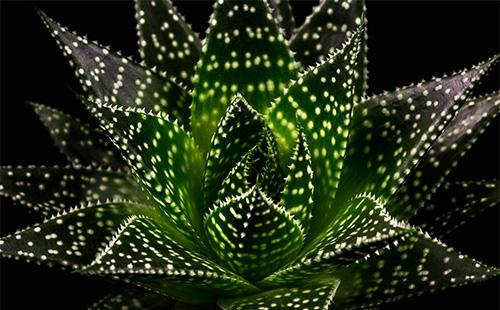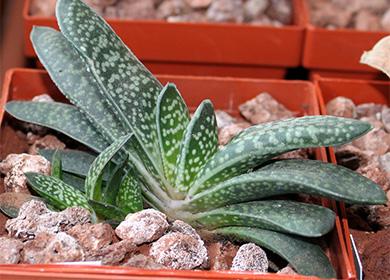The content of the article
Gasteria is a succulent plant of the asphodel family. It grows mainly in South Africa. It prefers desert, arid areas and mountain slopes.
Description and features of the flower
In the subject literature there are two versions of the origin of the name of the plant. One at a time, the word "Gasteria" translates as "pot-bellied vessel." On the other - "stomach." Both definitions quite accurately reflect the shape of the Gasteria flower. This is a beautiful succulent with fleshy leaves of an elliptical, slightly elongated shape, with pointed hard ends. Both sides of the leaf are covered with tubercles characteristic of the genus, spots of white color.
Grows slowly, forms compact bushes with age. The annual increase in gasteria is only a few centimeters. Depending on the type, the diameter of the outlet varies from 2 cm to half a meter.
Adult plants bloom with good care. Flowering occurs in the spring. The inflorescence is a long brush or whisk with flowers of white, red, pink or orange. The flowers are tubular, thickened below. Compared to leaves, the decorative effect of flowers is low.
Varieties and varieties
In total, about 100 species of succulent plants belonging to the genus Gasteria are known. No more than ten natural varieties are suitable for growing in apartments. In addition to them, breeders have bred a lot of beautiful and unusual hybrid varieties. Five species are considered the most popular.
- Gasteria warty. For the lingual form of fleshy leaves, it was called the deer tongue. The stem is absent. The height usually does not exceed 30 cm. The leaves are dark green in color, abundantly covered with white warts. During flowering, a thin, long peduncle rises from the sinus of one of the leaves. Flowers are collected in long brushes. Color varies from pink to bright red. Blossom begins in late spring. Several hybrid varieties have been developed that vary in size, number of warts, leaf shape and color.
- Gasteria is spotty. Dark hard leaves are characteristic. In young plants, the leaves are arranged in two rows, then gradually twist in a spiral. The surface of the leaves is covered with bright, elongated spots. The height of the stem is up to 30 cm. The colors of the flowers are different shades of red.
- Gasteria dwarf. A miniature, spectacular variety of Gasteria. The bush is very compact, the leaves are small, green, with white spots. In adult plants, leaves grow in a spiral. Peduncles short - no more than 10 cm. The flowers are small, red.
- Gasteria Armstrong. Very interesting, quite rare species. It differs from other varieties with wider leaves with many tubercles. With age, a spiral-shaped rosette is formed. The leaves are rounded, at the very tip of a small pointed outgrowth. During flowering, it releases panicled inflorescences with pink flowers.There is a hybrid variation of the variety, characterized by a different color of shoots on one plant - green and yellow. Yellow shoots die quickly.
- Gasteria is marble. A distinctive feature of the species is the marble color of the leaves. Fuzzy silver spots are scattered on a dark green background. The leaves are wide, lingual in shape, with a rounding at the top.
First steps after purchase
In the store, carefully inspect the plant. On fleshy leaves of Gasteria there should not be any spots, depressed and softened areas. Gasteria quickly rots with regular waterlogging.
How to care for gasteria after purchase? Put it in a bright but not sunny place, water moderately. The first week you can do without watering. It is not necessary to feed and spray. Dry content will help to identify pests at an early stage.
Quarantine lasts about two weeks. This time of Gasteria is enough to adapt to new conditions. After that, you need to transplant Gasteria into another pot with a complete replacement of the soil - peat transport substrates are not suitable for growing succulents. Ignite the soil before planting, prophylactically treat the gastria with low doses of fungicide and insecticide.
Gasteria care at home: recommendations for the grower
Growing Gasteria at home does not take much time. The plant is unpretentious, adapts to almost any temperature and irrigation regimes. But if you want to see its flowering and achieve high decorativeness, you need to adhere to certain growing rules.
- Lighting. Loves good lighting, but is afraid of the sun. The optimal location is the west and east side. Tolerates light shading. In a strong shadow on the north side, it grows, but is stretched and does not bloom from a lack of light. Burns remain on the leaves from the direct sun, the roots overheat. In summer, it can be taken outside, providing protection from winds, precipitation and the sun. In winter, additional fluorescent lighting is required - up to eight hours a day.
- Temperature. In spring and summer, good growth is observed at moderate temperatures of 18-25 ° C. In winter, Gasteria begins a dormant period - the temperature is gradually lowered to 6-12 ° C. Without a period of winter rest, Gasteria does not bloom.
- Humidity. Artificially increase the humidity is not worth it. Spraying is also not needed. As a hygienic procedure, Gasteria is sometimes bathed in the shower to remove dust. Residual moisture from leaf sinuses is removed to prevent decay. Bathing can be replaced by wiping the leaves with a damp soft cloth.
- Watering. How to water gasteria? In the summer - it is plentiful, but only after drying of the top layer of the substrate. It is better to skip one watering than to fill the plant. In winter, they are watered carefully, the amount of moisture is minimized.
- Top dressing. Fertilizers are applied only in the summer - the rest of the time the gasteria does not need them. Between top dressing maintain two-week intervals. You can feed with conventional complex mineral fertilizer, but it is better to take special products for succulents. The dosage is used small - two to three times lower than indicated by the instructions.
- The soil. Soil with an acidity of 5.5–7 pH is taken. The optimal composition is for two parts of deciduous land, one part of peat and coarse sand. For loosening, crushed brick is added. You can use ready-made soil mixtures for cacti.
- Transfer. Gasteria needs a regular transplant at intervals of one to two years. You can transplant in the spring and summer. They use the transshipment method - they move the gasteria into a new pot along with a lump of old earth.Capacity is not greatly increased - the plant develops better in tight pots. Be sure to provide for good drainage.

Breeding methods
Gasteria can be propagated by seeds, daughter sockets and a leaf. All methods give good results if you adhere to three recommendations.
- Sowing seeds. You can use the seeds collected from your plant or bought in a store. As a substrate, sand is used without additional additives. They fill a shallow container, level and moisturize from a spray bottle. Seeds are laid out on the surface without seeding. The container is covered with a film on top. Periodically, sand is sprayed, the greenhouse is ventilated, the temperature is maintained at the level of 15-20 ° С. After emergence, the film is removed. Seed germination takes one and a half to two months. Fortified seedlings can be planted in separate cups or small pots.
- By the kids. Children form near the main plant. Judging by the reviews of experienced gardeners, this is the best way to reproduce. When using children, the characteristics of the variety are fully preserved. Children are separated during transplantation, planted in small pots of the appropriate size.
- Leaves. Gasteria can be rooted with leafy cuttings. For rooting, choose healthy, adult leaves. Gently cut them with a sharp knife, leave to dry for two to three days. Rooted in slightly damp sand. The first three weeks planted cuttings do not water!
Growing errors and their consequences
Gasteria cultivation problems are rare. But sometimes, due to the errors of care, the decorativeness of the flower decreases. What mistakes do flower growers make most often? An analysis of the main problems can be found in the table.
Table - Mistakes for caring for Gasteria, their consequences and solutions
| Main signs | What is the reason | Ways to solve the problem |
|---|---|---|
| Pulling out rosettes, thinning and lengthening leaves | - Lack of light | - The location of Gasteria in a more lighted place; - illumination by fluorescent lamps |
| Bending the edges of leaf blades, fading of warts and spots | - Non-compliance with the parameters of the rest period; - high temperature in winter | - Lowering the temperature in winter to 6-12˚С |
| Twisting and drying leaves | - Warm wintering | - Organization of a full rest period |
| Gasteria curvature | - Lack of pot space | - Transplant into a new pot; - dropping extra kids |
| Leaf falling from touching them | - excess moisture | - Reduction of watering until the soil is completely dry; - normalization of irrigation regime |
| Yellowish or reddish shade of leaves | - Excess fertilizer | - Temporary cessation of top dressing; - Use of further fertilizers at a reduced dosage |
| Darkening and decay of leaves | - Excess moisture at low air temperature | - Transplantation with the removal of rotten areas; - Reduced watering |

Pests and methods of dealing with them
Gasteria is susceptible to the attacks of many common pests of indoor plants. As a preventive measure, it is recommended to systematically inspect the plant for insects. The first signs of damage and pest control methods are described in the table.
Table - Gasteria pests
| Insect name | Signs of occurrence | Methods of struggle |
|---|---|---|
| Aphid | - Colonies of brown or green small insects; - sticky coating on the leaves | - Bathing Gasteria using a solution of laundry or potash soap; - spraying with a solution of the drug "Actara" |
| Spider mite | - Small bright points on the leaves; - thin web | - Increase in humidity; - spraying with the drug "Spark bio", "Neoron", "Agravertin" - putting on a plastic bag to enhance the effect after processing |
| Mealybug | - Whitish wax coating on the leaves; - lumps of "cotton wool" in the axils of the leaves; - yellowing of the plant | - Bathing in the shower using green potash soap; - treatment with Aktara |
| Shield | - Brown convex plaques; - sticky drops on the leaves | - Mechanical removal of scutes from gasteria; - spraying with the drug "Aktara" |
| Thrips | - Small black dots; - silver dark plaque on the leaves | - Spraying with Fitoverm |
Diseases are less common. The only misfortune of Gasteria is gray rot, which causes decay as a result of heavy irrigation at low air temperature. The treatment of decayed plants consists in cutting out all the affected areas, transplanting the gasteria into dry, sterile soil with preliminary treatment with fungicides.
Since it is not difficult to take care of the gastery, it is suitable for busy people, beginners, useful for landscaping office rooms. An unpretentious plant all year round will delight owners with beautiful greenery, and sometimes elegant flowers.

